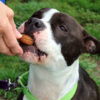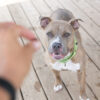Note: These exercises can be adapted to entering and exiting cars and other motor vehicles.
Is your dog afraid of steps and stairways?
Perhaps past experiences led the dog to associate steps with something unpleasant, frightening and/or hurtful. Perhaps the dog was yelled at for going up or down a stairway, or had fallen down stairs during his formative weeks, or was pushed down the stairs. Maybe the dog has never encountered stairs before.
Some people respond to such fears by forcing the dog up and down the stairs. But this approach doesn’t always provide the dog with an opportunity to overcome his fear. In addition, a fearful dog may try to nip or bite as a means of expressing “I’m terrified of the stairs!”
Many canine behavior specialists recommend helping the dog work through their stairphobia through the use of positive reinforcement including verbal praise, treats and other positive non-punishing motivators and counter-conditioning. Before attempting any of the exercises suggested in this tip sheet, visit your vet to rule out the possibility that the dog does not have an injury or medical condition that is making it painful to walk up or down stairs.
Preventing the Development of Fear of Stairs
Take the time to properly socialize your puppy. Make sure that by 16 weeks of age, the pup is exposed to various things, people and situations (such as stairways) that he may encounter during his life. Do your best to keep all experiences during these impressionable weeks safe, secure and happy.
If you’ve adopted a more mature dog, remember that socialization continues throughout the dog’s lifetime. Practice the same exercises as for puppy socialization.
Training your Dog to Climb and Descend Steps without Fear
When introducing your pup or dog to stairs, work to gradually build their confidence. Start with just approaching the stairway. Reward them for making baby steps – any show of progress, no matter how small. Slowly introduce treats and verbal reinforcement into the training scenarios. Besides food treats, positive reinforcement tools include playing with your dog and providing a favorite toy for quick romp sessions.
You can use tasty treats or a favorite toy as a lure, placing it on the “target” step as you work with your dog.
After the dog shows signs of comfort with approaching the steps, practice going up one step. Then turn and go back down the step. Practice this several times, praising the dog for any sign of progress and any sign of reduced anxiety.
Note: some trainers suggest advancing on the stairs beside the dog. Others suggest staying just behind the dog since a shy or fearful dog will usually find this less intimidating than having someone towering over him.
Next ascend and descend two steps. Again, praise and reinforce for any progress. Repeat until the dog is willingly managing the steps. Add a few more steps at a time.
When you are ready to climb to the top of a stairway, make sure you have several particularly high-value treats on hand. You want to give your dog the idea that contrary to being scary, or leading to a scary place, stairs lead to good feelings and things…such as tasty treats.
Take care not to rush the process, or else you will risk a setback.
Be patient. You might aim to devote 2 or 3 days to working on each “step” (approaching the stairway, touching the first step, climbing the first step, climbing a couple more steps, etc).
When the dog is comfortable heading in one direction (such as down the steps), reverse direction…again taking things slowly. Note: many dogs are more scared of going down stairs, so their owners often start working with them on going up stairs.
When the dog is comfortable going up and down that flight of stairs, practice the same exercise on a different stairway. Remember dogs do not generalize well on their own.
Another approach, which can be blended with the previous counter-conditioning strategy: instead of feeding your dog in the kitchen or wherever you usually feed him, put the dog’s food bowl at the top of bottom of the stairway in your home, whichever is closest to the dog’s regular feeding area.
When the dog exhibits comfort with eating in this new area, move the food bowl to the first step. As soon as the dog seems relaxed and accepting and willing to eat at this step-side spot, move the food bowl to the next step. Keep going gradually, so the dog will learn that the stairs are not a scary place after all.
Here is another technique. While we do not advocate forcing a dog up or down stairs, some dogs will respond to a combination of firm physical encouragement and happy talk, which conveys to him that you, the leader, are not afraid of the stairs and to trust you. Before attempting this exercise, teach your dog to move forward in response to the command “heel” or “let’s go” in a non-threatening situation such as when out on walks. For the stairway exercise, place the dog in a harness, so that you are not pulling on his neck. Firmly grasp the harness at the point between the dog’s shoulders. Then use the command “heel” or “let’s go” and descend the steps with your hand on the harness, firmly navigating the dog down the steps by your side. Move steadily forward, without pause, so that your dog does not have a chance to contemplate his anxiety.
As you descend together, praise your dog verbally (GOOD DOG), then provide a treat at the bottom of the stairs. Work to keep your dog’s eyes focused on you, and not on the steps or the space beyond you. A key goal is to help your dog learn to trust you and to help him realize that you are not going to let him get hurt. Repeat several times. If the dog continues exhibiting fear, follow the first technique described above.
After the dog becomes comfortable going down the steps, reverse direction.
Even after your dog appears to lose his anxiety about steps, make the effort to provide continued opportunities to ascend and descend stairways to reinforce the new association that “stairs are OK and even lead to good things.








